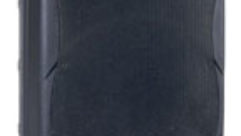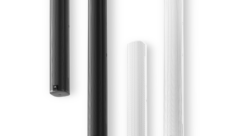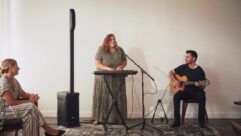
JBL EON 515XT
Apr 4, 2011 4:12 PM,
by John McJunkin

JBL EON 515XT
As an audio professional, I’ve been fascinated by the development of small, self-powered, lightweight speakers on a stick. These speakers have vastly simplified the notion of providing good-quality audio without breaking the bank or back of the person who loads in the gear, whether it be a coffee shop guitarist, DJ, presenter, AV professional, or worship sound person. The speakers get smaller, lighter, and better sounding all the time. The manufacturers who create them continue to raise the bar and challenge each other for market domination – the result of which is an ever-improving product. JBL has introduced the latest update to its venerable EON series speaker: the EON 515XT, which is the fourth generation in the line. This revision’s improvements over the original EON 515 include more powerful amplification, increased input sensitivity, a lower noise floor, and improved EQ controls.
The speaker’s enclosure is just about as small as can contain the drivers and amp, contributing to its light weight and portability. It’s formed of very tough polypropylene, road-proven over many years of use and abuse. An important result of JBL’s choice to use polypropylene rather than a birch cabinet is weight savings, and in this case, it’s substantial. The EON 515XT weighs in at 32.5lbs, as compared with wood cabinet speakers of similar size that typically tip the scales at 45-55lbs. The user’s back will be grateful for this difference. By virtue of the speaker’s light weight, it’s plausible to pick it up and carry it like luggage, and to that end, JBL has included comfortable carry handles on the top and both sides of the enclosure. A moderately strong person can carry one of these pretty easily, but a really strong person will have no trouble toting two. The enclosure also features a nice powder-coated perforated steel grille with an acoustically transparent cloth backing. The enclosure very cleverly conceals its five M10 suspension points with plastic caps in order to avoid a distraction from its aesthetics. As a matter of fact, the speaker’s pull-back point is concealed underneath a badge labeled “500 Series” on the rear of the cabinet—if you didn’t know any better, it wouldn’t even exist.
In addition to the speaker’s suspension points, it features feet on the bottom so it can be placed on a level surface, and angled feet on each side so it can be used as a floor wedge monitor. And of course, there is a receptacle at the bottom of the cabinet for speaker-on-a-stick applications. This receptacle is slightly funneled, making insertion of the support pole a bit easier. A wingnut tightens to fasten the speaker to the pole. The speaker’s rear panel is dominated by a large aluminum heat sink, which exhibits a nice matte black finish that I presume to be anodization. Below the heat sink are the controls and I/O connections. The speaker’s integrated three-input mixer offers two line-level inputs with 1/4in. TRS jacks and a single mic-level input with a jack that will accept both 1/4in. TRS plugs and XLR mic connectors. Below the mic-level input, a recessed pushbutton switch determines whether the input is looking for mic or line level. Above each input is an input level knob. To the right of these inputs are found an XLR loop output and bass and treble knobs, which offer 6dB of boost or cut (with the shelf frequencies at 200Hz and 4kHz, respectively). This is more sophisticated than the original 515’s three-position EQ slider switch, and a nice upgrade. A green LED to the left of the EQ knobs indicates signal presence, and a red LED above that indicates that the speaker’s limiter is engaged. Below the loop output connector is a recessed pushbutton “mix/loop” switch. When it’s engaged, it passes a post-EQ blend of all three of the mixer’s inputs. When it’s disengaged, it passes only the un-processed signal present at input three (the one that accepts both mic and line-level signals). Another recessed pushbutton switch illuminates the JBL logo on the front of the cabinet. An IEC power inlet and a power switch are at the bottom of the panel.
The 15-inch LF driver in the EON 515XT features JBL’s Differential Drive technology with dual 2-inch voice-coils. This is the same technology that is used in the celebrated Vertec line arrays, and it’s pretty impressive. The speaker’s internal two-channel Class D amplifier, developed by Crown Audio, delivers 525W of power to the LF driver, a full 50 percent more than the original 515. The HF driver gets 100W and the crossover point is located at 1.7kHz, which is 500Hz lower than the crossover point of the original 515. This sounds better to my ear and it provides a smooth transition between drivers. The enclosure topology is bass reflex, with dual ports on the front of the cabinet. This definitely lends to the low-end thump of these speakers.
I’d had the benefit of A/B comparing a pair of original 515s against a pair of the second-generation G2 EONs, and the fidelity of these speakers has continually improved with each subsequent revision. I discovered that the extra power to the LF driver in the case of the 515XT made a substantial difference in the low end. Considering the fact that these speakers are most likely not going to be acoustically coupled to a floor, JBL increased the power to ensure that copious bass is available, and indeed, there is plenty. The 200Hz roll-off of the bass boost/cut control thankfully does not increase the muddiness of the low end when boosting, like many such bass controls are known to do. The published maximum SPL for the entire package is 132dB, and I can say, at least subjectively, that it’s all there*mdash;plenty loud when driven by a solid input signal. As to the high end, it is delivered by a horn, and it sounds like a horn, but it sounds good—not harsh or splatty. In practice, the user will want to be mindful of the 100 degrees horizontal by 60 degrees vertical dispersion pattern of the horn, of course, but if so, coverage can be nicely directed where it’s wanted.
JBL EON 515XT
Apr 4, 2011 4:12 PM,
by John McJunkin
The published frequency range of the system (-10dB) is 39Hz to 20kHz, while the published frequency response (±3dB) is 42Hz to 18kHz, and this is a fair assessment by my ear. As always, a speaker-on-a-stick like this can always benefit from the addition of a subwoofer, but make no mistake, the low end is solid and impressive right out of the 515XT box. JBL also achieved the goal of reducing the noise from the speakers while they’re at rest, and the input stage facilitates a nice, loud, clear signal.
I listened to a broad range of material from classical to metal to speech to jazz, and found that the EON 515XT is definitely an improvement over its predecessor. I was impressed with that predecessor, and even more so by the new update. It’s a powerful tool for coffee shop performers, AV professionals, and DJs alike, and I’d recommend it for consideration.
John McJunkin is the principal of Avalon Podcasting in Chandler, Arizona. He has consulted in the development of studios and installations and provides high quality podcast production services.
Product Summary
- Company: JBL Professional
www.jblpro.com - Product: EON 515XT
- Pros: Very lightweight, solid SPL output, enhanced EQ
- Cons: Horn sounds like a horn
- Applications: Coffee shop, AV, DJ, sales, house of worship
- Price: $899
Specifications
- System Power Rating: 625W (525 + 100)
- Frequency Range (-10dB): 39Hz—20kHz
- Dimensions (HxWxD): 26.5″x16″x14.5″
- Maximum SPL: 132dB
- Frequency Response (±3dB): 42Hz—18kHz
- Input Impedance: 14kΩ
- Mic Input Gain: -∞ to +40dBu
- Line Input Gain: -∞ to +4dBu (+18dBu max)
- Amplifier Topology: Crown Class D
- LF Driver: JBL 265F-1 15-in.
- HF Driver: JBL 2414H 1.5-in.
- Coverage Pattern: 100 degrees H x 60 degrees V nominal
- Crossover Frequency: 1.7kHz
- Net Weight: 32.5lbs










